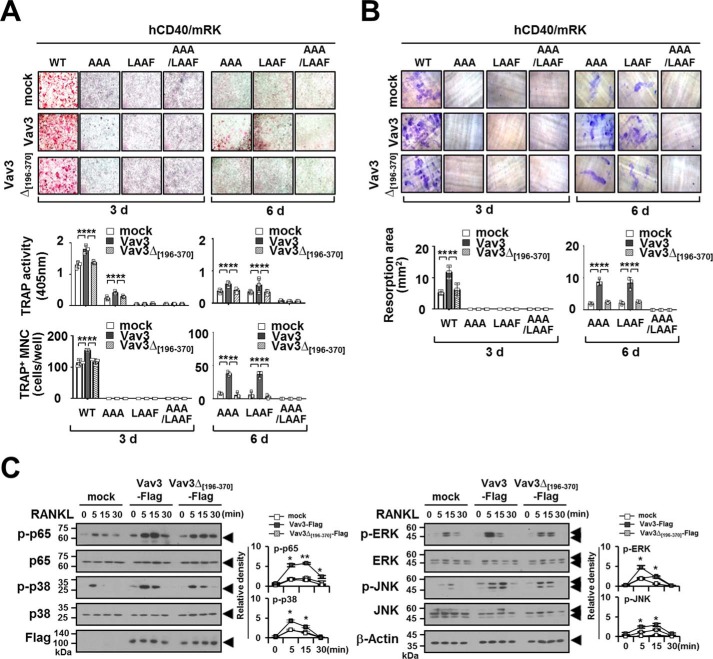FIGURE 10.
Vav3 expression enhances osteoclastogenesis via a chimeric hCD40-RANKcyto receptor lacking either T6BSs or the IVVY motif. A, the effect of Vav3 or DH domain-deficient Vav3 expression on OC differentiation via a chimeric hCD40-RANKcyto receptor lacking either T6BSs or the IVVY motif. Puromycin-selected BMMs expressing hCD40-RANKcyto with Vav3 or DH domain-deficient Vav3 were differentiated into OCs with M-CSF (50 ng/ml) and the anti-human CD40 monoclonal antibody G28–5 (100 ng/ml) for 3 or 6 days. The OCs were photographed (top panel, original magnification, ×50) after TRAP staining. The OCs were analyzed using a TRAP solution assay (middle panel). The number of TRAP+ MNCs (at least three nuclei) was counted (bottom panel). mock, empty vector control. **, p < 0.01. B, the effect of Vav3 or DH domain-deficient Vav3 expression on resorption pit formation via a chimeric hCD40-RANKcyto receptor lacking either T6BSs or the IVVY motif. Resorption pits were visualized (top panel, original magnification, ×50). The summarized data from the resorption pit assays are shown in the bottom panel. C, the effect of Vav3 or DH domain-deficient Vav3 expression on RANKL-induced signaling pathways. Puromycin-selected BMMs expressing Vav3 or DH domain-deficient Vav3 were cultured for 2 h under serum-free conditions. The BMMs were stimulated with RANKL (100 ng/ml) for the indicated times and subsequently analyzed via immunoblotting (IB) with antibodies that recognized phosphorylated and total NF-κB p65 (Ser536), p38 (Thr180/Tyr182), ERK (Thr202/Thr204), and JNK (Thr183/Tyr185). The cell lysates were normalized for total protein content. The level of Vav3 expression was detected via anti-FLAG (M2) IB. The relative level of phosphorylated forms was calculated after normalization to total protein input (right). β-Actin was used as a loading control. The relative level of phosphorylated forms was calculated after normalization to total protein input (right). *, p < 0.05. All experiments were performed at least three times with similar results.

